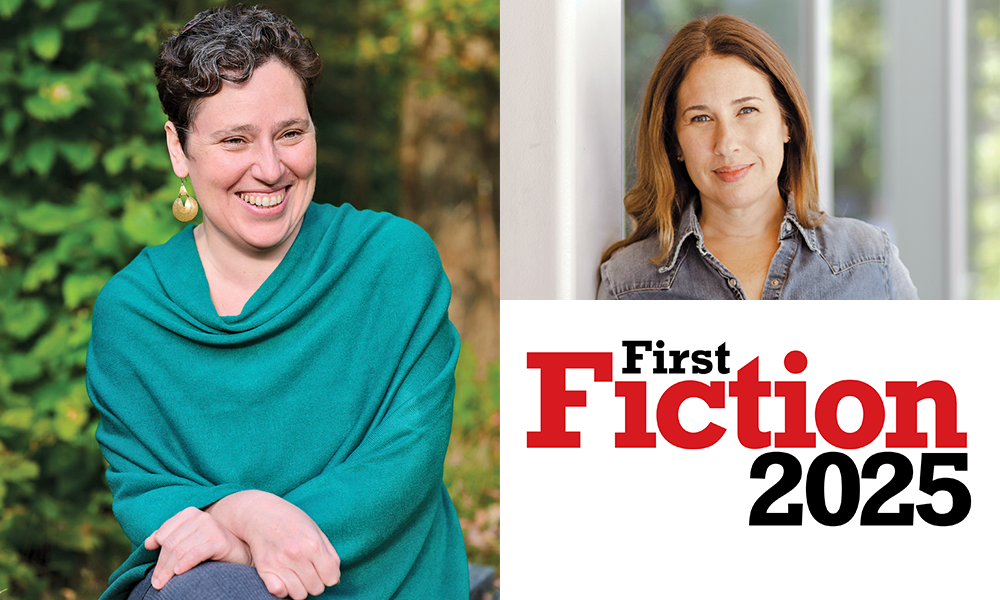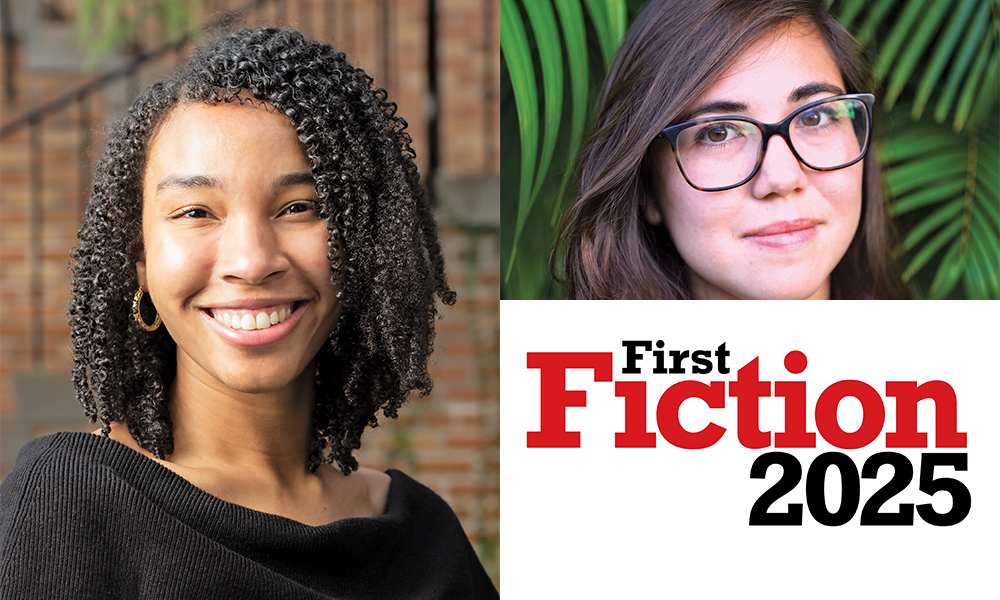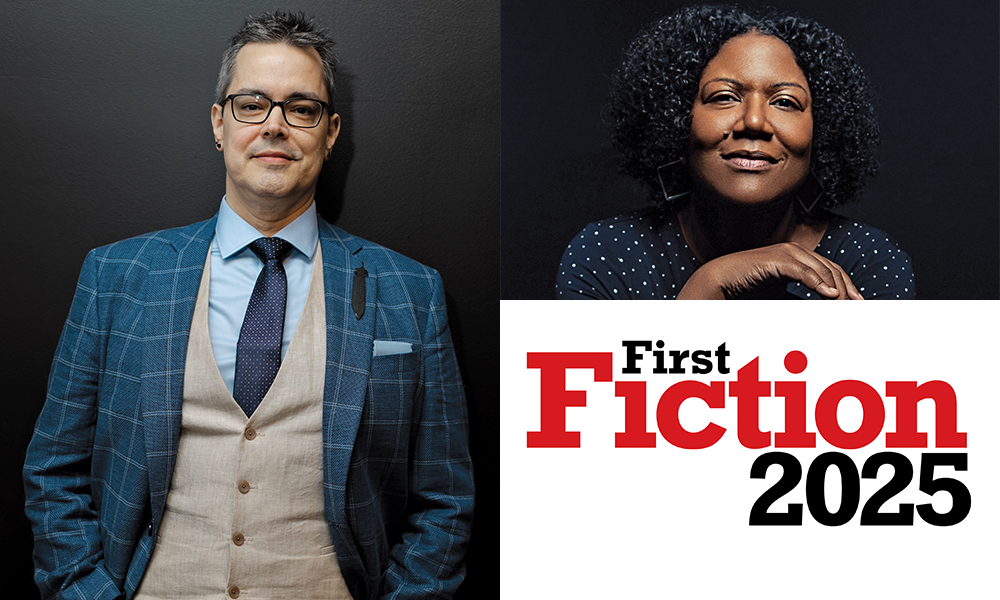For our twenty-fifth annual roundup of the summer’s best debut fiction, we asked five writers to introduce this year’s group of debut authors. The result is intimate and honest conversations covering craft, the writing process, and publishing, as well as the very real life experiences and contemplations that have led each author to imagining wholly original creative worlds. Worlds full of humanity, humor, pain, and hope—that old friend.
Lauren Grodstein talks with Sarah Yahm about her novel, Unfinished Acts of Wild Creation: “As my mother declined she manifested the same inexplicable neurological symptoms as me, as if we had the same sadistic choreographer,” says Yahm. “This book exists inside that simultaneous love and distaste, otherwise known as intimacy between daughters and their ailing mothers.” David Heska Wanbli Weiden interviews Jon Hickey, author of the novel Big Chief. “The themes started as questions: Who ‘belongs’ to a tribe or nation? Who gets to decide? How does one get to that seemingly impossible state of satisfaction?” asks Hickey. Megan Kamalei Kakimoto talks with Carrie R. Moore about her story collection, Make Your Way Home: “In a way, I grew up alongside this book. My standards got higher. I learned to be simultaneously careful with my characters’ portrayals and honest about history,” says Moore. Honorée Fanonne Jeffers and Aaron John Curtis discuss Curtis’s novel, Old School Indian, and its origin as a shorter form. “The short story was basically an exercise, working through my fear of death and anger at [the possibility of] dying young—I was dealing with health issues much like what Abe experiences in the novel,” says Curtis. “Support and encouragement from a writers group I’d been in for a couple of years helped me expand it into a novel.” And Jonathan Escoffery introduces Jemimah Wei, author of The Original Daughter, a novel: “Interrogating our desires is a way of intentionally cultivating the vision our art grows out of, which comes back to asking the age-old question of how we want to live,” Wei says.
Unfinished Acts of Wild Creation (Dzanc Books, May) by Sarah Yahm
Big Chief (Simon & Schuster, April) by Jon Hickey
Make Your Way Home (Tin House Books, July) by Carrie R. Moore
Old School Indian (Hillman Grad Books, May) by Aaron John Curtis
The Original Daughter (Doubleday, May) by Jemimah Wei
sarahyahmlaurengrodstein.png

Sarah Yahm, whose debut novel, Unfinished Acts of Wild Creation, was published by Dzanc Books in May, introduced by Lauren Grodstein, author of seven books, most recently the novel A Dog in Georgia, forthcoming in August from Algonquin Books. (Credit: Yahm: Storyworkz; Grodstein: Rosie Simmons)
![]()
The strangest thing happened to me after I read Sarah Yahm’s exhilarating Unfinished Acts of Wild Creation: For weeks the novel’s characters started popping up in my memories like they were dear old friends. I saw a Chasidic family walking together on a Saturday and thought of Leon, a therapist who takes on as a patient a teenager who has begun to merge prayer with OCD. I scheduled my mammogram and thought of Lydia, the daughter who knows that both her mother and grandmother died of a heritable disease. And as I made dinner for my kids, I thought of Louise, the mother who runs away from her family to spare them the pain of watching her die.
This novel—deft, exuberant, and heartbreaking—follows Leon and Louise Rosenberg over decades as they meet, fall in love, and create a family, only to have their household break apart under the pressure of Louise’s diagnosis. Woven through their lives together are their individual journeys into art, music, academia, and psychotherapy. As a family drama, Unfinished Acts of Wild Creation is about the often fractious relationships between husbands and wives, parents and children. But it’s also about selfishness and anger, ritual and forbearance, debate, argument, hope. Most and best of all, it’s about the amazing gift of sharing our lives with the people we love.
The Jewish family has long been a site for memorable works of fiction. Did you read Jewish family dramas as you were becoming a writer? Do you see your work in conversation with the work of other Jewish authors?
My father definitely pushed Philip Roth on me at an early age, and I read Portnoy’s Complaint and Goodbye, Columbus, but I was unmoved. I think even at age fifteen I found them vaguely, or not so vaguely, misogynistic. When I became a reader in my own right, the Jewish writers that influenced me the most were “Jews with Politics,” as my grandmother would say. Politics equaled the left wing—all other politics were lowercase. For me that meant Grace Paley and Tony Kushner.
When you read Grace Paley, she doesn’t use quotation marks because the language of her characters’ thoughts and speech is inherently blurred, just like the line between generations is blurred. In her stories you step into an ongoing stream of conversation, and then you step out at the end, but the conversation continues without you. She also moves seamlessly from kitchen table to political protest. There is no artificial distinction between the domestic and the political, which I also think is elementally Jewish. All we ever did at the dinner table was argue about religion and politics, which was fantastic. I learned so much.
I discovered [Kushner’s play] Angels in America: A Gay Fantasia on National Themes during my sophomore year of college, and it blew my mind. In the opening scene a rabbi is officiating a funeral for an old immigrant Jew. The rabbi describes this woman’s journey from Europe to America. Then he says to her descendants, “In you that journey is.” I think about that sentence all the time because that’s what I’m attempting to articulate and trace—the undefinable inheritance of history and trauma and memory. The Yiddish inversion of that sentence has its own elegant beauty. It brings me to tears every time I recite it, actually, which makes me feel silly, but it’s true.
Also, and this may sound silly as well—keep in mind that I have a six-year-old—but all the children’s books I read as a kid were written by Jews: Russell Hoban, Lore Segal, Arnold Lobel. There’s an essay kicking around in my head about the Frog and Toad series and how Toad represents the Jewish experience. There’s a deadpan surrealism, a grumpy vulnerability in those books that influenced me profoundly, a desperation for intimacy combined with the terror of loss. What can I say? I really identify with Toad. He’s such a lovable, grumpy catastrophizer, and there’s nothing more I aspire to be.
In this novel the Rosenbergs grapple with a hereditary neurodegenerative disease, which is not something I often read about in contemporary fiction, even though so many people I know worry about their genomic inheritances. Why did you turn to this particular subject? Was it a challenge to write about?
As somebody with an inherited illness—luckily not a terminal or degenerative one—I think about literal and metaphorical genetic transmission all the time. This book emerged out of three simultaneous states of existential terror: new motherhood, disability, and caring for a dying parent. In the span of two years I was all of my characters at once: a mother and a daughter, a patient and a caretaker, and a frustrated artist. I have a hypermobility disorder, common for Ashkenazi Jews, that was exacerbated by pregnancy and childbirth. During pregnancy I experienced a series of inexplicable neurological symptoms, semi-involuntary repetitive movements. They abated after birth, and frankly nobody’s ever really been able to figure out what caused them.
As my mother declined she manifested the same inexplicable neurological symptoms as me, as if we had the same sadistic choreographer. The literal connection between our two bodies terrified me. I felt a horrible tenderness for her, an overwhelming love, and also a profound distaste, a desire to distance myself from her intense vulnerability. I was terrified of becoming her. This book exists inside that simultaneous love and distaste, otherwise known as intimacy between daughters and their ailing mothers.
One of the things I love about this book is that it is so frank about sex—not just the act, but also the complicated ways people can feel about the act. Why did you choose to be so forthright about sex and sexuality in a family saga?
Sex is woven into the book, even though there aren’t a lot of sex scenes per se—although there are some memorable ones in the first chapter. Spoiler alert: A tarantula is tangentially involved. But sex as a normal part of life is absolutely integrated into the nonstop barrage of conversation among these family members, which mimics my family growing up. I was raised by two hippie-adjacent psychoanalysts, so not much was off-limits conversationally or intellectually.
But I don’t think this book is about sex as much as it is about embodied experiences in general. In the novel I’m forthright about the act, but I’m also forthright about breastfeeding, postpartum depression, illness, and death. There’s a moment in Unfinished Acts of Wild Creation when Lydia, one of the main characters, is talking to her best friend, Sylvie, who’s an editor for romance novels. Sylvie’s complaining about all the absurd euphemisms for penises that she has to read—“throbbing member,” etcetera. It’s meant to be funny, but it’s also kind of a real problem. As a writer I’m constantly trying to figure out how to talk about bodies in a way that doesn’t rely upon clichés or the grotesque. The impoverished language for bodily experiences in our society makes it harder for us to discover how we feel in our own bodies. It isolates us from each other. The language that we do have forces us to experience sex, death, and birth according to rigid and limiting cultural scripts.
The project of this book was to explore the unspoken ways we understand our physical experiences and give it language. For example, when Louise Rosenberg [Lydia’s mother] gets sick, she experiences her illness as a C-sharp note. Lydia experiences the same illness as brackish water rising. I experience pain in terms of color. None of this matches the pain scale you’re provided in a doctor’s office. This book is an invitation for people to explore the unarticulated experiences of their own bodies and speak them out loud in the metaphors that make sense to them. And I think doing this will make us all have better sex and get better health care.
The book is also really funny. How much of your own personality is reflected in your writing style?
Oh, I am my characters, and my characters are me. Let’s just say I’m a lot. I live in central Vermont—where people are earnest and few have a Jewish, ironic, loudmouthed, dark sensibility—and I am constantly making people uncomfortable. They either decide that I’m a charming eccentric or they cross the dirt road when they see me coming. But I don’t really care. I’m forty-six, we’re living under fascism, you get what you get. My mother used to embarrass me as a kid because she didn’t believe in dialing it back. She used to say, “Dignity is overrated,” and now that I’m a grown-up I couldn’t agree more. Whether it’s creating an off-the-cuff song about poop and performing it for a group of five-year-olds or seeing what happens when one of my characters unwraps her mother’s burritoed corpse, I believe in taking spontaneous creative risks. Everything I write is tragedy combined with playfulness. I’m picturing them right now plotted on x- and y-axes, although it’s not that literal. Whenever my work veers toward the sentimental or the melodramatic, I pull it back with a carefully calibrated act of appalling honesty, or maybe even a fart joke. Also, I think historically oppressed peoples have traditionally developed dark senses of humor, and Jews definitely fit the bill. The only way we’re going to survive the next few years is to walk around with an internal Lenny Bruce–style commentary on the world around us.
An excerpt from Unfinished Acts of Wild Creation
Maternal Math
1996
While Lydia was ranting at dinner about the latest betrayal by her best friend Billie, Louise focused on holding the knife steady in her right hand.
“I just don’t understand why she didn’t invite me to that party,” Lydia was saying.
Mind over body, Louise repeated in her head, bringing her right hand toward the pork loin on her plate. But just as she was about to cut the pallid piece of meat, an electric burst shot through her fingers, and her knife clattered against the porcelain plate in a staccato rhythm. She glanced up helplessly at Leon, hoping Lydia hadn’t noticed. She had. In the slow seconds before Leon calmly took her steak knife and began to cut her meat, Louise saw the panic in both of their eyes.
For the past few weeks, “Dinner with Louise” was starting to feel like an experimental John Cage composition. Shake the glass a little more so we can get the bass notes of the cup against the table, Imaginary John Cage told her. And come in a little earlier with the dancing fork routine? But I like what you’re doing with the jittery-leg-on-chair. You’re still making music, Louise, you’re still making music. Imaginary John Cage was so supportive. He never looked at her with thinly disguised terror, unlike Leon, who was currently carrying on a perfectly normal conversation with Lydia, pretending he wasn’t cutting his wife’s meat into tiny pieces as if she were very young or very old.
“Billie’s just exploring different facets of her identity, honey,” Leon said calmly, but she could see his shoulders hiked up almost to his ears. “And you remind her of who she really is. Or at least who she used to be, and so she’s distancing herself.”
“Billie’s a fucking cunt,” Louise said, even though she hadn’t been paying attention to the conversation, but considering Billie was a sixteen-year-old girl, she figured it was probably accurate, and it was her job to say something outrageous and unreasonable when Leon used his didactic therapist voice. Leon and Lydia laughed, clearly relieved to see some remnant of the old Louise still inhabited the broken-down body sitting in her chair at the kitchen table. I can do this on autopilot, Louise thought.
“Thanks for the astute analysis, Mom,” Lydia said sarcastically, but what she really meant was, Thanks for letting me believe that I still have a mother.
“Anytime kiddo,” Louise replied to both the spoken and the un-spoken words. But she didn’t really mean it, because pretending she wasn’t altered was starting to feel even more exhausting than being sick.
The next night was nearly identical. So similar, in fact, that for a second Louise thought she was in an anxiety dream where she was doomed to repeat this dinner over and over. Lydia complained about the exact same party, in the exact same terms, wearing the exact same Doc Martens and Ani DiFranco T-shirt. Does she ever wash that fucking shirt? Should I be washing that shirt? If I weren’t sick, would I have already washed that shirt? There was the same steamed broccoli on her plate, the same chipped salad bowl to her right. But then she looked more closely and saw that tonight’s bland meat was chicken, not pork loin, and that Leon had carefully cut it up for her into tiny squares to avoid a repetition of yesterday’s impromptu knife-on-plate concerto.
Her right hand sat traitorously in her lap, humming. It was like her hand was composed of strings that were tuned too tightly, and when she went to pick up the fork, those strings would snap and her hand would clatter uncontrollably against the plate. She knew she wouldn’t be able to spear the bits of chicken and broccoli and bring them to her mouth, but if she didn’t even try, Leon would say, “You have to keep up your strength!” and Lydia would say, “Mom, you’re not eating?” in that slightly desperate tone.
She glanced at the table again, noticing Leon hadn’t even provided her with a knife. This is so fucking infantilizing, she thought. Why doesn’t he just chew it up and regurgitate it on my plate like a wolf? That would be less humiliating. For a split second, she indulged her fury at Leon and the impossible paradox he’d created—she needed to eat to keep them from worrying about her, but if she tried to eat and her hand failed, they’d worry about her even more. She tried to will her hand to behave, but it twitched in her lap, tapping silently against her knee. She wondered if she was communicating something in Morse code, if her hand was tapping out SOS. But to whom? Who would rescue her from this? No one.
The texture of the room changed imperceptibly. The air thickened around her, and the light simultaneously dimmed and brightened. She was both in the room and not in the room.
I think I’m about to have a panic attack, she thought as she felt the essence of herself, her Louise-ness, move out of her body and up toward the ceiling. Peering down at the three of them from above, in this strange light, they looked like painted versions of themselves. It was all so wholesome, like a Jewish Norman Rockwell. All you’d have to do is paint over the furrows on Leon’s forehead, erase the stains from Lydia’s ever-present T-shirt, and paint out Louise’s disobedient hand. In fact, maybe paint out Louise altogether and paint in some other, healthier mother.
From Unfinished Acts of Wild Creation by Sarah Yahm, published by Dzanc Books on May 6, 2025. Reprinted with permission.




